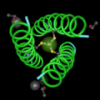Sometimes I think the field of biology suffers from collective amnesia. Like the girl in the movie "50 first dates," we discover things over and over and every time we find something, we forget that it's ever been found before. This is especially true if a phenomenon has been discovered in a biological subfield, like microbiology or virology.
Over 26 years ago, microbiologists found that Bacillus subtilis uses different DNA signals (alternative promoters) to control the expression of genes related to development (1).
Now, it turns out that this phenomenon is widely employed in the human genome as well.
An interesting press release (2) from the Howard Hughes Medical Institute described a paper from Phil Green (and colleagues) at the University of Washington (3). They found that 40-50% of human and mouse genes are able to use alternative promoter sequences. (A promoter is a special sequence that tells RNA polymerase where to start making an RNA copy of DNA). Interestingly, the alternative promoters may have a developmental role since they're more active during development of an embryo.
I think that's pretty neat. But, since I knew about Bacillus, I wasn't quite as surprised by the phenomenon as the authors of the paper. It seems like many phenomena in bacteria or viruses (with the exception of operons) might be found to have counterparts in the human genome eventually.
Nevertheless, it looks like human genetics might be catching up to microbiology.
References:
1. Moran CP Jr, Lang N, Banner CD, Haldenwang WG, Losick, R. Promoter for a developmentally regulated gene in Bacillus subtilis. Cell. 1981 Sep;25(3):783-91.
1. Alternative Ways of Reading DNA Have Spurred Evolution
2. Baek, D. et. Al. 2007. Characterization and predictive discovery of evolutionarily conserved mammalian alternative promoters. Genome Research 17:145-155, 2007.

At least four of the mammalian genes I worked with contain alternative promoters (IGF-I, IGF-II, androgen receptor, and IL-1RA genes). Thus, I am not surprised. IGF-II is quite interesting since it contains four alternate promoters in human and sheep of which only three are conserved in rodents. For the human androgen receptor gene two overlapping promoters have been described. The two IL-1RA promoters drive the expression of two different isoforms since one of the alternate first exons encodes a signal peptide while the other doesn't.